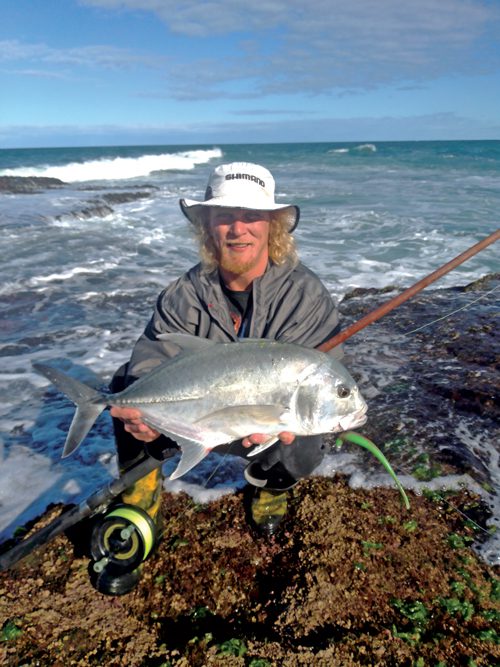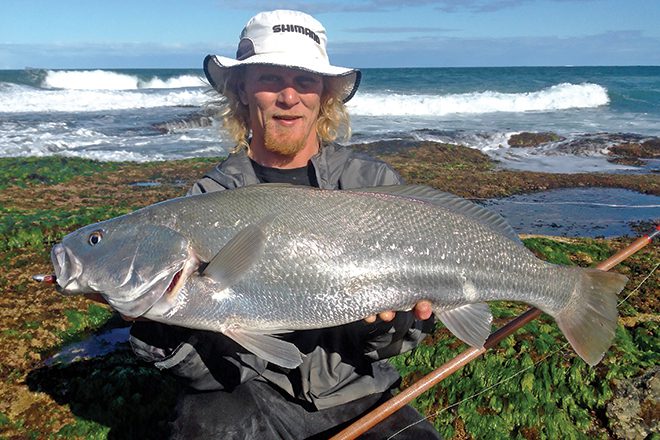Fishing along the Clarence Coast of northern NSW during September was fair to middling, with good numbers of jewfish being taken from inside the Clarence River along the breakwalls and around the headlands.
Whiting started to show up inside the river and increase in both size and numbers, and this trend should only continue to improve as we head into summer.
Meanwhile luderick catches began to wane in the river, as the bulk of the fish moved back out along the walls and headlands after spawning.
Flathead, both large and small, are readily available inside the Clarence year-round, as are the nice pan-sized fish that can be found in the shallow gutters along the beaches.
Normally by September, the large schools of flat-tail mullet have already made their way back upstream after spawning in the lower reaches during winter, however this year, they stayed around for an extra couple of moons.
This was a bonus for Mischa and his cousin Guy Stewart of Lismore, as they found a few nice late-season fish at the old ferry approach at Iluka, using both lures and live mullet, and with the best fish weighing at slightly over 16kg.

Sadly, the mullet have now moved on and we are left to do the hard yards, such as spinning the headlands or baiting out along the breakwall, which is a tad more effort than simply fishing beside your vehicle.
The Iluka Bluff has been fishing very well for solid school jew during daylight hours on a variety of lures, including 6” jerk shad soft plastics, 14cm shallow-diving hard-bodied minnows and 60g white feathers.
Naturally enough, in most cases a good covering of white water is required to camouflage your chosen lure, so those not confident fishing alone during a reasonable swell should buddy up and fish with a friend.
White water is not required when fishing around the headlands at night, however you do need an ultra-shallow running lure and retrieve at a dead-slow speed.
Signs such as birds diving and feeding on bait just prior to dark is almost a guarantee that a smelly old jew won’t be far away.
October is the time to start drowning whole octopus on the river side of the wall during a couple of hours either side of slack high water during the day or, if that’s not for you, try using live yellowtail or a whole or stripped torpedo squid during the same tide at night – this will also work a treat.
We’ve had a ball recently, getting among some quality early season whiting along the southern bank of Goodwood Island – using live beachworms during the run-in tide at night saw nearly every fish measure over 30cm.
We prefer to fish for whiting at night because you don’t have those pesky little pickers stealing your bait, as they tend to do when fishing during the day.
Also, whether it be day or night, we fish the deeper drop-offs and channels, not the shallow sand flats.

In recent weeks, tailor have gone into hiding, with only a handful of fish being taken from the bluff and Woody Head on metal lures, and the occasional fish along Main Beach and up along Ten Mile Beach at Shark Bay.
As is the case every year, good big bream are still to be had fishing in the wash around the headlands, however a lot of the fish, while long, are in poor condition after spawning.
A mixed feed of tarwhine, bream and whiting along the open beaches should be on the cards this month, with fresh pipis or live worms being the pick of bait to use.
I know a few offshore fishos who can’t wait until the end of next month, when the first catches of spotted mackerel from the shallow waters of Woody Head are reported.
In the meantime, they’ll have to settle for reasonable bags of snapper, teraglin and the occasional nice jew.
So, for October, whiting, flathead from the rivers and beaches and jewfish from the walls and headlands should give you ample choice of a feed of fresh fish.
And, given that all the true weather forecasters are predicting a lot more rain this spring and summer, I’d be making the most of every fine day possible.
Until next month, safe fishing.
 Bush 'n Beach Fishing Magazine Location reports & tips for fishing, boating, camping, kayaking, 4WDing in Queensland and Northern NSW
Bush 'n Beach Fishing Magazine Location reports & tips for fishing, boating, camping, kayaking, 4WDing in Queensland and Northern NSW








